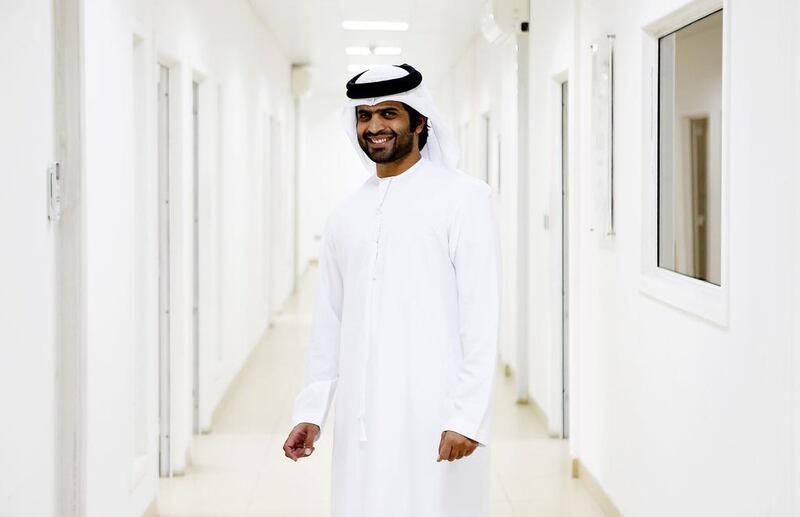'People think the UAE is all about shopping malls," says Ahmed Al Maazmi, photographer and author of Dar Al Ezz, a new book that pays tribute to the country's heritage via a series of striking photographs.
"It has so much more to offer," he adds. "Visitors should look beyond the Burj Khalifa and Dubai Mall and discover beautiful landscapes and a rich, varied culture. Dar Al Ezz is an ode to the UAE. It is a reflection of the society, people and history, and shows what the country is really about."
The hardback book showcases 160 pictures across more than 140 pages, and looks beyond Dubai and Al Maazmi’s home emirate of Sharjah. It contains images from all seven emirates, giving readers a fascinating glimpse into life beyond luxury hotels and air-conditioned malls.
Dar Al Ezz is the photographer's third publication. His first two, Zoom Al Mahbara and The Pearl of the Homelands, were met with acclaim, and motivated him to embark on this latest project.
“It took three years to publish the book,” he says. “It’s a slow process to photograph a location, pass the image to the designer and edit it in Photoshop. You then have to seek approval from the Government to publish each picture. It’s not easy.”
A father of two, Al Maazmi pursues his hobby during the cooler months when there’s more life and colour outdoors.
“I don’t have a specific style, but I like to shoot during winter,” he says. “Physically, it’s more comfortable, and psychologically, I can more easily reflect what I want to say because the colours are richer and there’s more nature.”
Against each image, Al Maazmi writes its location and a line to describe the beauty. Pictures include desert dunes, Dubai Creek and a wooden dhow at dawn.
“I have tried to capture the beauty of the country with pictures that bring into focus small, beautiful things that are invisible to many,” he says. “The book talks deeply about our hospitality and humble culture.
“It is an expression of appreciation and gratitude, and helps immortalise the nation’s sites. I hope it gives us memories we can cherish forever and takes readers far away from the world of digital images.”
Al Maazmi wanted to accurately document the country in a traditional book, not on social media. “A book carries more prestige than a collection of images published online,” he says. “Digital media is effective at reaching large numbers of people across the world, but I wanted a medium that carries more value, something that can’t be deleted at the click of a button.”
The power of social media hasn’t escaped him, however. With more than 2,000 followers on Instagram and Twitter, he’s keen to improve his online skills and build a bigger fan base.
“I’ll post other pictures online and help inform people of sites where they can experience UAE culture and heritage,” he says. “Today, there are lots of online promotions to visit Hatta. Until recently, it was hidden away, people didn’t know about it. Now it is one of Dubai’s main attractions.”
Al Maazmi believes that few people understand the UAE’s culture and heritage. “I want to help change that,” he says.
The long-standing employee of Sharjah Electricity and Water Authority knows the country better than most. So what are his top visitor recommendations?
“There are so many,” he says. “For nature, Jebel Al Jais in Ras Al Khaimah, Liwa Desert in Abu Dhabi and Al Madam on the Sharjah/Hatta Road are among my favourite places,” he says. “Al Ain is also worth visiting, especially Jebel Hafeet.”
Al Maazmi became interested in photography in 2005. After shooting pictures on his mobile phone, he decided to buy a professional camera to capture a higher resolution and more professional feel. He practised extensively and gradually improved his technical skills.
Today, Al Maazmi continues to push himself, earmarking video, and specifically drone technology, as a field he would like to explore. He plans to travel and publish books that compare a country’s modern and traditional life. “I want to produce many photography books, not just on the UAE but on the whole world,” he says.
With such ambition, what advice does the Emirati have for aspiring photographers? “Keep going, learn new skills and remember the sky is the limit,” he says.
What three things do you pack when you go travelling?
Camera, cowboy hat and sunglasses.
How do you relax?
I travel to special resorts surrounded by nature. I love Switzerland, in particular.
Where do you go for adventure?
The United States. It’s great for exploring new places such as waterfalls and forests that not many people know about.
What’s your favourite tourist attraction in the UAE?
Jebel Hafeet [pictured] and Jebel Jais for the nature, especially in winter.
What’s your favourite building in the UAE?
The Burj Khalifa. I’m proud that it’s the tallest building in the world and I’m proud that it’s named after the president of the UAE.
What’s your favourite hobby?
I have three: travel, adventure and photography.
Which book are you reading at the moment?
Khawlah Al Tayer by Malameh Soboh.
What’s the best part of Emirati culture?
Good manners – we respect everyone. The way we dress is unique, too. I’m proud of our kandura because it’s clean and tidy, and presents us well. It reflects our good manners.
What’s your favourite Emirati food?
Machboos and balaleet – I have been eating these dishes since I was a boy. I still love them, especially when my mother is the cook.
What’s the best piece of advice you have ever received?
One of my fans told me in an online forum to publish Dar Al Ezz in print, not online. It was an excellent suggestion.
weekend@thenational.ae





